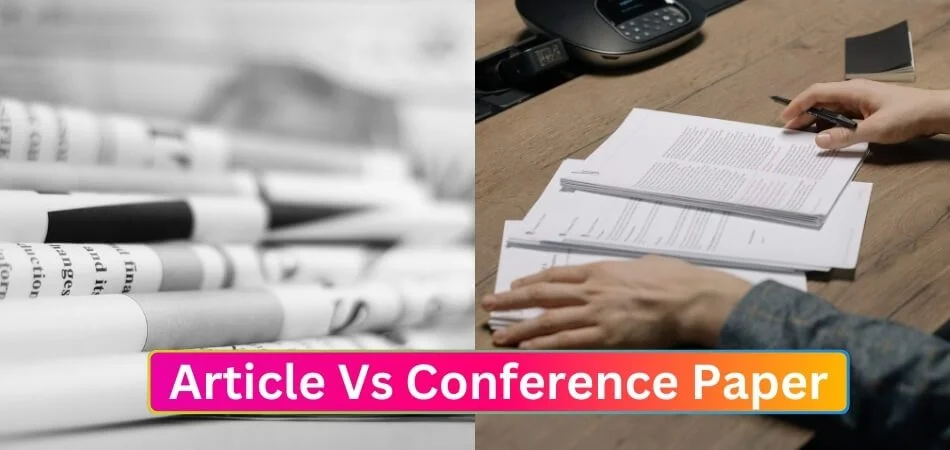In the academic world, the distinction between different forms of scholarly communication is crucial. “Article Vs Conference Paper” is a topic that delves into this very differentiation.
An article, typically found in academic journals, is a comprehensive piece often subjected to stringent peer review. Its focus is primarily on presenting original research in a detailed manner.
Contrastingly, a conference paper is usually a more concise exposition, presented in academic conferences. It tends to be somewhat less formal and might not undergo as extensive a peer review process as journal articles.
This comparison sheds light on the nuances of academic writing and its various platforms. Continue reading to explore the intricate differences and unique aspects of each format, and how they contribute to the realm of academic discourse.
What is the Article and Conference Paper?
In the academic sphere, articles and conference papers are two fundamental but distinct types of scholarly communication. Articles are detailed studies published in journals, often after rigorous peer review, emphasizing original research. Conference papers, presented at academic gatherings, offer a more concise format and may undergo less stringent review. An article is a thorough exploration of a specific topic designed for publication in academic journals. It undergoes a rigorous peer review process, ensuring a high standard of research quality and originality.
On the other hand, a conference paper serves as a shorter, more immediate form of scholarly communication, often presented in a less formal setting and possibly subject to less extensive review. These papers provide a platform like Global Conference to share preliminary results and ideas, fostering scholarly discussion and collaboration.
Different Types of Articles
The realm of academic publishing is rich with various types of articles, each serving a unique purpose in scholarly communication. Researchers and academics can choose the right format for their work by understanding these types. These articles range from presenting original research to reviewing existing literature.
Original Research Articles
Original research articles are the backbone of academic journals, presenting new and original scientific findings. Authors share methodologies, data, analysis, and conclusions, contributing novel insights to their field. These articles undergo rigorous peer review, ensuring the credibility and validity of the research.
Review Articles
Review articles synthesize existing literature on a specific topic, offering comprehensive overviews and insights. They critically analyze multiple research studies, identifying trends, gaps, and future research directions. These articles are valuable for researchers needing an aggregated understanding of a subject.
Case Studies
Case studies focus on specific instances or subjects, providing detailed analysis and insight. They offer in-depth exploration of unique cases, contributing to understanding complex phenomena or conditions. These articles are particularly prevalent in fields like psychology, medicine, and business.
Methodological Articles
Methodological articles delve into the development of new research methods or the refinement of existing ones. They discuss the approach’s effectiveness, applicability, and potential limitations. These articles are crucial for advancing research techniques and methodologies.
The diversity of article types in academic literature provides a comprehensive toolkit for researchers. Each type serves a distinct purpose, from presenting groundbreaking research to reviewing existing knowledge, thereby enriching the academic discourse and fostering continual learning and discovery.
Different Types of Conference Papers
Conference papers, integral to academic discourse, come in various forms, each serving a unique purpose in the scholarly community. These papers facilitate the exchange of ideas, research findings, and methodologies among experts. Understanding the different types of conference papers is essential for navigating academic conferences effectively.
Full Papers
Full papers are comprehensive reports of completed research, offering in-depth analysis and robust data. These papers undergo a thorough review process, similar to journal articles, ensuring high-quality contributions to the field. They typically address a significant research question, providing detailed methodology, analysis, and conclusions. Full papers are often published in conference proceedings or special journal issues.
Short Papers
Short papers, or extended abstracts, focus on concise presentations of preliminary or ongoing research. These papers are shorter, offering a snapshot of the research, its objectives, and potential impacts. Short papers are ideal for generating discussion and feedback, which is crucial for further development. They often lead to future full papers or journal articles.
Position Papers
Position conference papers present an argument or stance on a particular topic, often sparking debate and discussion. These papers are less about presenting research findings and more about offering perspectives, theories, or critiques. Position papers are instrumental in shaping future research directions and fostering collaborative efforts. They are a common feature in panels and roundtable discussions at conferences.
Workshop Papers
Workshop papers are typically presented in smaller, more interactive conference sessions. They focus on specific themes, encouraging detailed discussions and collaborative problem-solving. Workshop papers often lead to tangible outcomes, like collaborative projects or special journal issues. They provide a unique opportunity for networking and in-depth exploration of niche topics.
Conference papers are a cornerstone of academic communication, with each type playing a vital role in the dissemination and evolution of knowledge. Understanding these varieties helps researchers and scholars choose the proper format for their work, ensuring effective and impactful presentations at academic conferences.
Are Articles and Conference Papers one and the Same?
No, articles and conference papers are not the same, though they share the common goal of disseminating knowledge in the academic world. Articles are detailed studies published in scholarly journals, undergoing a rigorous peer-review process. Conference papers, on the other hand, are typically presented at academic conferences and may follow a less formal review process.
An article is a comprehensive exposition of research, often contributing new insights to a field of study. It undergoes a stringent review, ensuring the research’s validity and originality. Articles are designed for long-term impact and reference within the academic community.
In contrast, a conference paper serves as a platform for presenting preliminary findings or ongoing research. It facilitates immediate feedback and discussion among peers, being less detailed than articles. Conference papers are often seen as stepping stones to further, more in-depth research and publications.
Article Vs Conference Paper- What are the Major Differences?
A fundamental understanding of the differences between articles and conference papers is crucial in the academic world. Both serve to disseminate research but in distinctly different formats and contexts. Highlighting their significant differences helps scholars choose the suitable medium for their work.
Purpose and Focus
Articles are in-depth works that contribute substantial knowledge to a particular academic field. They typically present original research, offer comprehensive analyses, and may introduce groundbreaking theories or findings. Their primary goal is to add to the body of scholarly literature in a significant way.
In contrast, conference papers are more about sharing initial findings or ongoing research with peers. They aim to ignite discussion, receive feedback, and foster collaboration, which is pivotal for refining and advancing research.
Review Process
The peer-review process for articles is notably rigorous, involving multiple revisions to ensure the highest academic standards. This process validates the research’s credibility, accuracy, and contribution to the field. Articles often go through several rounds of critique and improvement before publication.
Conference papers, while also subjected to peer review, generally face a less stringent and quicker review process. The emphasis is on providing a platform for presenting emerging ideas rather than on exhaustive scrutiny.
Publication Venue
Articles find their place in academic journals, which are permanent scholarly records. These journals are accessible for long-term academic reference, allowing for sustained impact and citation in future research.
Conference papers, in contrast, are primarily presented at academic conferences and may be included in conference proceedings. While these proceedings are accessible, they are often seen as less permanent and prestigious compared to journal publications, serving more as a record of the conference itself.
Length and Detail
Articles are characteristically longer and more detailed, covering all aspects of the research topic. They include an extensive review of existing literature, detailed methodology, comprehensive results, and in-depth discussions. This format allows for a thorough exploration of the research subject.
Conference papers, on the other hand, are brief and focused on key findings and methodologies. Their brevity is designed to suit the time constraints of conference presentations, making them more suitable for introducing research and its initial results.
Audience and Reach
Articles are tailored for a wide academic audience, often transcending the boundaries of a single conference or discipline. They aim to reach and influence researchers, scholars, and practitioners across various fields.
Conversely, conference papers target a more specific audience, usually the attendees of a particular conference who are often specialists in a related field. Their impact is more immediate within the context of the conference, serving as a platform for current discussion and networking.
Articles and conference papers, while both crucial to academic communication, serve distinct roles within the scholarly ecosystem. Understanding these differences helps researchers and scholars effectively disseminate their findings, contribute to their fields, and choose the most suitable medium for their work.
Pros and Cons of Using Articles
Articles are a cornerstone of academic research, offering a detailed and credible platform for presenting original studies. They play a pivotal role in advancing knowledge across various disciplines. However, like any medium, they come with their own set of advantages and limitations.
Pros
- Provide in-depth and comprehensive analysis of research topics.
- Undergo rigorous peer review, ensuring high standards of quality and accuracy.
- Offer a permanent record in academic literature, aiding long-term citation.
- Facilitate wide dissemination of research findings across global academic communities.
- Contribute significantly to the body of knowledge in a field.
- Enhance the author’s credibility and reputation in their academic community.
- This can lead to further research, funding opportunities, and collaborations.
Cons
- The publication process can be time-consuming and lengthy.
- Journal subscription fees may limit access to some articles.
- Highly competitive, with a lower acceptance rate for many journals.
- It can be challenging for new researchers to navigate publication guidelines.
- Risk of research needing to be updated due to lengthy publication timelines.
While articles are essential for the detailed and credible presentation of research, they are accompanied by challenges, such as a potentially lengthy publication process and access limitations. Understanding these pros and cons helps researchers make informed decisions about publishing their work.
Pros and Cons of Using Conference Papers
Conference papers play a pivotal role in the dissemination of academic research, offering unique advantages and some limitations. They serve as a platform for sharing ideas and fostering academic dialogue. Understanding their pros and cons is essential for researchers and academics.
Pros
- Immediate Feedback: Provides an opportunity for researchers to receive direct feedback from peers and experts.
- Networking Opportunities: Facilitates connections with other researchers and academics in the field.
- Faster Dissemination: Allows for quicker sharing of ideas and findings compared to journal publications.
- Encourages Collaborations: Opens avenues for collaborative research projects and partnerships.
- Preliminary Findings Showcase: Ideal for presenting initial research results or ongoing studies.
- Professional Development: Enhances presentation skills and boosts academic profile.
- Diverse Perspectives: Exposes researchers to a variety of viewpoints and methodologies within their field.
Cons
- Less Rigorous Review: Often undergoes a less stringent peer-review process than journal articles.
- Limited Detail: Typically shorter in length, offering less detail compared to comprehensive articles.
- Lower Impact Factor: This may have a lesser impact in terms of citations and academic recognition.
- Limited Audience Reach: Primarily targets conference attendees, which can limit broader exposure.
- Short-term Focus: Emphasizes immediate discussion rather than long-term scholarly contribution.
In summary, conference papers are an integral part of academic research, offering swift dissemination and valuable networking opportunities. However, they come with certain limitations in terms of detail, review rigor, and long-term impact. Recognizing these aspects helps researchers strategically choose the right platforms for presenting their work.
Bottom Lines
The article Vs conference paper debate highlights the importance of understanding the distinct roles these two forms of academic communication play. Articles, with their in-depth analysis and rigorous peer review, contribute significantly to the body of scholarly literature, offering a permanent record for future reference.
On the other hand, conference papers provide a more immediate platform for presenting and discussing preliminary findings, fostering collaboration and networking within the academic community. While articles ensure long-term impact and credibility, conference papers allow for quicker dissemination and feedback, crucial for ongoing research development.
Recognizing the differences between these formats is essential for researchers in choosing the appropriate medium for their work, balancing the depth and immediacy of their scholarly contributions. This understanding also helps in mitigating potential drawbacks, such as the less rigorous review of conference papers and the longer publication timeline of articles.









